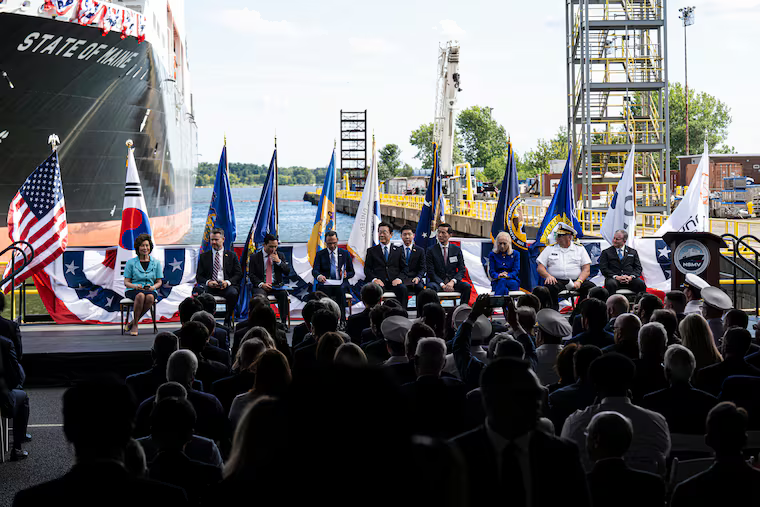
Featured in The Philadelphia Inquirer
By Alfred Lubrano
South Korea will build a nuclear-powered submarine in Philadelphia, President Donald Trump announced this week.
Writing on Truth Social, Trump said:
“South Korea will be building its Nuclear Powered Submarine in the Philadelphia Shipyards, right here in the good ol’ U.S.A. Shipbuilding in our Country will soon be making a BIG COMEBACK. Stay tuned!!! President DJT.”
The submarine would be constructed at the Hanwha Philly Shipyard, which is owned by the South Korean company Hanwha Group.
South Korean President Lee Jae Myung visited the shipyard in August for a christening ceremony where he joined Gov. Josh Shapiro and other U.S. officials to promote a trade, investment, and military partnership they said should vastly increase employment and production at the facility.
Previously, Hanwha Group had announced a $5 billion infrastructure investment that they said would transform Philadelphia into an American shipbuilding capital.
Hanwha said it wanted to more than double the workforce of 1,700 welders, operators, and contractors it employs locally, and hoped to accelerate its construction times from the current one ship every eight months to more than one a month.
South Korean officials sporting hats that said “Make American Shipbuilding Great Again” joined the celebration — but complications soon arose.
In September, U.S. immigration agents arrested around 475 workers at a Hyundai plant in Georgia in a sweep known as “Operation Low Voltage,” Reuters reported. Most of the workers were South Korean nationals. It was the largest single-site enforcement operation in the Department of Homeland Security’s history.
Many of the workers were in the country illegally, immigration officials said. It was believed at the time that the arrests could ratchet up tensions between Washington and Seoul, affecting trade agreements — including plans to augment shipbuilding in Philadelphia.
“The raid has left many Koreans feeling betrayed,” according to an opinion piece published in The Philadelphia Inquirer earlier this month by Jeffrey Voth, president of Herren Associates, an engineering and technology firm with an office in the Philadelphia Navy Yard.
After Trump’s post, Hanwha chief strategy officer Alex Wong issued a statement expressing enthusiasm about supporting shipbuilding as a “central plank in the U.S.–Korea alliance.” At the Hanwha Philly Shipyard, he said, “a revived American shipbuilding sector will benefit U.S. workers and enhance the security of both countries.”
In a separate statement addressing the Hyundai incident, Hanwha officials said the company “is committed to full compliance with the U.S. immigration system.”
Reached Thursday afternoon, Voth indicated that, now with Trump’s imprimatur, the United States is “carving out a gateway for skilled Korean engineers and technicians to come here” to begin the early stages of the submarine project.
Building the kind of submarine Trump referenced requires enormous capital and effort, said Christopher Scafario, president and CEO of the Delaware Valley Industrial Resource Center, an economic development group at the Philadelphia Navy Yard.
“A nuclear-powered submarine is one of the most complex things that can be built,” he added. “It’s up there with manufacturing a spacecraft. But it could very well be done.”
Already, manufacturers within a 100-mile radius of Philadelphia are engaged in building about 25 percent of the parts that go into similar submarines, Scafario said.
“They’re all part of the supply chain — the people that make pipes, fittings, control panels, gauges for maritime use,” he said. “With this proposed submarine, shipbuilding will be an enormous part of our region’s growth, like meds and eds (hospitals and universities).”
Job creation would accelerate, especially for welding, machining, and fabrication work, which pays low six-figure salaries, Scafario said.
City officials declined to comment on the project.
Currently, there are more than 200 nuclear-powered vessels in the world, the vast majority submarines and aircraft carriers, according to the World Nuclear Association. The U.S. Navy operates 79 of the warships, 68 of which are submarines. Russia, China, the UK, France, India — and now, potentially, South Korea — have the rest.
Nuclear power in this context refers not to weapons of mass destruction but to how a submarine moves through the water: these boats use nuclear reactors that heat water to produce steam for turbines that power their main engines, generators, and other machinery.
According to A.J. Mitchell, a research fellow at Australian National University writing in The Conversation, many of these vessels can operate for 80 years without refueling.
People have raised questions about the safety of building a nuclear reactor in a city like Philadelphia. The risk of nuclear leakage and environmental damage “could be much worse than oil pollution,” according to Nautilus Shipping, a ship management company offering technical and environmental support.
Still, the risk from radiation exposure associated with naval nuclear propulsion is low compared to risks normally accepted in industrial work and daily life, according to the Naval Nuclear Propulsion Program.
The Clean Air Council in Philadelphia declined to comment.
There was a problem decades ago that may have previously discouraged building nuclear-propulsion vessels in the city. After World War II, scientists conducted nuclear fusion work at the Navy Yard.
“There was a fairly bad accident that caused casualties,” Scafario said. “That’s what elevated concern about doing work like this in the past.”
Staff writer Joseph DiStefano contributed to this article.
